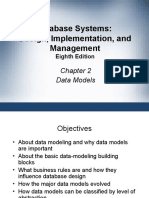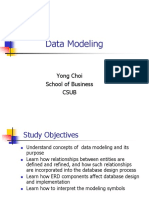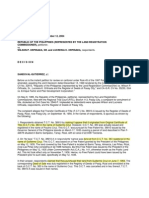Chapter4-Introduction To SQL
Uploaded by
tinishdharanChapter4-Introduction To SQL
Uploaded by
tinishdharanDatabase Systems: Design,
Implementation, and
Management
Eighth Edition
Structured Query Language (SQL)
Objectives
• In this chapter, you will learn:
– The basic commands and functions of SQL
– How to use SQL for data administration (to
create tables, indexes, and views)
– How to use SQL for data manipulation (to add,
modify, delete, and retrieve data)
– How to use SQL to query a database for useful
information
Database Systems, 8th Edition 2
Introduction to SQL
• SQL functions fit into two broad categories:
– Data definition language
– Data manipulation language
• Basic command set has vocabulary of less than
100 words
• American National Standards Institute (ANSI)
prescribes a standard SQL
• Several SQL dialects exist
Database Systems, 8th Edition 3
Data Definition Commands
• The database model
– In this chapter, a simple database with these
tables is used to illustrate commands:
• CUSTOMER
• INVOICE
• LINE
• PRODUCT
• VENDOR
– Focus on PRODUCT and VENDOR tables
Database Systems, 8th Edition 4
Database Systems, 8th Edition 5
Creating the Database
• Two tasks must be completed:
– Create database structure
– Create tables that will hold end-user data
• First task:
– RDBMS creates physical files that will hold
database
– Differs substantially from one RDBMS to another
Database Systems, 8th Edition 6
The Database Schema
• Authentication
– DBMS verifies that only registered users are
able to access database
– Log on to RDBMS using user ID and password
created by database administrator
• Schema
– Group of database objects that are related to
each other
Database Systems, 8th Edition 7
Data Types
• Data type selection is usually dictated by nature
of data and by intended use
• Supported data types:
– Number(L,D), Integer, Smallint, Decimal(L,D)
– Char(L), Varchar(L), Varchar2(L)
– Date, Time, Timestamp
– Real, Double, Float
– Interval day to hour
– Many other types
Database Systems, 8th Edition 8
Creating Table Structures
• Use one line per column (attribute) definition
• Use spaces to line up attribute characteristics
and constraints
• Table and attribute names are capitalized
• NOT NULL specification
• UNIQUE specification
Database Systems, 8th Edition 9
Creating Table Structures (continued)
• Primary key attributes contain both a NOT
NULL and a UNIQUE specification
• RDBMS will automatically enforce referential
integrity for foreign keys
• Command sequence ends with semicolon
Database Systems, 8th Edition 10
SQL Constraints
• NOT NULL constraint
– Ensures that column does not accept nulls
• UNIQUE constraint
– Ensures that all values in column are unique
• DEFAULT constraint
– Assigns value to attribute when a new row is
added to table
• CHECK constraint
– Validates data when attribute value is entered
Database Systems, 8th Edition 11
SQL Indexes
• When primary key is declared, DBMS
automatically creates unique index
• Often need additional indexes
• Using CREATE INDEX command, SQL indexes
can be created on basis of any selected
attribute
• Composite index
– Index based on two or more attributes
– Often used to prevent data duplication
Database Systems, 8th Edition 12
Data Manipulation Commands
• INSERT
• SELECT
• COMMIT
• UPDATE
• ROLLBACK
• DELETE
Database Systems, 8th Edition 13
Adding Table Rows
• INSERT
– Used to enter data into table
– Syntax:
• INSERT INTO columnname
VALUES (value1, value2, … , valueN);
Database Systems, 8th Edition 14
Adding Table Rows (continued)
• When entering values, notice that:
– Row contents are entered between parentheses
– Character and date values are entered between
apostrophes
– Numerical entries are not enclosed in
apostrophes
– Attribute entries are separated by commas
– A value is required for each column
• Use NULL for unknown values
Database Systems, 8th Edition 15
Saving Table Changes
• Changes made to table contents are not
physically saved on disk until:
– Database is closed
– Program is closed
– COMMIT command is used
• Syntax:
– COMMIT [WORK];
• Will permanently save any changes made to
any table in the database
Database Systems, 8th Edition 16
Listing Table Rows
• SELECT
– Used to list contents of table
– Syntax:
• SELECT columnlist
• FROM tablename;
• Columnlist represents one or more attributes,
separated by commas
• Asterisk can be used as wildcard character to
list all attributes
Database Systems, 8th Edition 17
Updating Table Rows
• UPDATE
– Modify data in a table
– Syntax:
UPDATE tablename
SET columnname = expression [, columnname =
expression]
[WHERE conditionlist];
• If more than one attribute is to be updated in
row, separate corrections with commas
Database Systems, 8th Edition 18
Restoring Table Contents
• ROLLBACK
– Undoes changes since last COMMIT
– Brings data back to pre-change values
• Syntax:
– ROLLBACK;
• COMMIT and ROLLBACK only work with
commands to add, modify, or delete table rows
Database Systems, 8th Edition 19
Deleting Table Rows
• DELETE
– Deletes a table row
– Syntax:
DELETE FROM tablename
[WHERE conditionlist ];
• WHERE condition is optional
• If WHERE condition is not specified, all rows
from specified table will be deleted
Database Systems, 8th Edition 20
Inserting Table Rows with a
SELECT Subquery
• INSERT
– Inserts multiple rows from another table (source)
– Uses SELECT subquery
– Subquery: query embedded (or nested) inside
another query
– Subquery executed first
– Syntax:
INSERT INTO tablename SELECT columnlist
FROM tablename;
Database Systems, 8th Edition 21
SELECT Queries
• Fine-tune SELECT command by adding
restrictions to search criteria using:
– Conditional restrictions
– Arithmetic operators
– Logical operators
– Special operators
Database Systems, 8th Edition 22
Selecting Rows with
Conditional Restrictions
• Select partial table contents by placing
restrictions on rows to be included in output
– Add conditional restrictions to SELECT
statement, using WHERE clause
• Syntax:
SELECT columnlist
FROM tablelist
[ WHERE conditionlist ] ;
Database Systems, 8th Edition 23
Deleting a Table from the Database
• DROP
– Deletes table from database
– Syntax:
DROP TABLE tablename;
• Can drop a table only if it is not the “one” side
of any relationship
– Otherwise RDBMS generates an error message
– Foreign key integrity violation
Database Systems, 8th Edition 24
Advanced SELECT Queries
• Logical operators work well in the query
environment
• SQL provides useful functions that:
– Count
– Find minimum and maximum values
– Calculate averages, etc.
• SQL allows user to limit queries to:
– Entries having no duplicates
– Entries whose duplicates may be grouped
Database Systems, 8th Edition 25
You might also like
- Database Systems: Design, Implementation, and Management: Advanced SQLNo ratings yetDatabase Systems: Design, Implementation, and Management: Advanced SQL52 pages
- Chapter 3-Database Systems Eighth Edition PresentationNo ratings yetChapter 3-Database Systems Eighth Edition Presentation55 pages
- Database Systems: Design, Implementation, and Management: Introduction To Structured Query Language (SQL)No ratings yetDatabase Systems: Design, Implementation, and Management: Introduction To Structured Query Language (SQL)55 pages
- Database Systems: Design, Implementation, and Management: The Relational Database ModelNo ratings yetDatabase Systems: Design, Implementation, and Management: The Relational Database Model52 pages
- Best Practices Guide For Instructional DesignNo ratings yetBest Practices Guide For Instructional Design8 pages
- IT For Outcomes: Selecting A Database For Monitoring (Meghani 2011)No ratings yetIT For Outcomes: Selecting A Database For Monitoring (Meghani 2011)9 pages
- Chapter 05 Database Systems and Applications100% (1)Chapter 05 Database Systems and Applications20 pages
- For Power BI Installation:: Get Data: To Get The Data From Different Sources Like CSV, Excel, Test, SQL, Access Etc..No ratings yetFor Power BI Installation:: Get Data: To Get The Data From Different Sources Like CSV, Excel, Test, SQL, Access Etc..11 pages
- Information Systems Analysis and DesignNo ratings yetInformation Systems Analysis and Design29 pages
- Introduction To MS Power BI Desktop - Exercise 02 - Deeper Understanding Power BI ETL - V03No ratings yetIntroduction To MS Power BI Desktop - Exercise 02 - Deeper Understanding Power BI ETL - V036 pages
- Jeffrey A. Hoffer, V. Ramesh, Heikki Topi: Modern Database Management 12 EditionNo ratings yetJeffrey A. Hoffer, V. Ramesh, Heikki Topi: Modern Database Management 12 Edition32 pages
- Chapter I - The Database Environment and Development Process50% (2)Chapter I - The Database Environment and Development Process14 pages
- Dam301 Data Mining and Data Warehousing Summary 08024665051No ratings yetDam301 Data Mining and Data Warehousing Summary 0802466505148 pages
- Presentation ON RDBMS: Submitted By-Dilpreet Singh Joginder Singh Class - Mba (Bu) 3 SEM100% (3)Presentation ON RDBMS: Submitted By-Dilpreet Singh Joginder Singh Class - Mba (Bu) 3 SEM11 pages
- Database and Data Warehouse Assignment 1No ratings yetDatabase and Data Warehouse Assignment 115 pages
- Lec 2 Data Modeling and Database DesignNo ratings yetLec 2 Data Modeling and Database Design10 pages
- Collecting and Using Information To Strengthen Citywide Ost Systems August 2011No ratings yetCollecting and Using Information To Strengthen Citywide Ost Systems August 201122 pages
- Lecture3 - Relational Data Model and Relational ConstraintsNo ratings yetLecture3 - Relational Data Model and Relational Constraints33 pages
- Unit #2 - Data Warehouse and Data MiningNo ratings yetUnit #2 - Data Warehouse and Data Mining51 pages
- Chapter 1 - Introduction To Databases: 2-What Is A DatabaseNo ratings yetChapter 1 - Introduction To Databases: 2-What Is A Database13 pages
- CSC290 Critical Review Grading Rubric: A 8-10 B 7-7.9 C 6-6.9 D 5-5.9 F 5 Summary (20%)No ratings yetCSC290 Critical Review Grading Rubric: A 8-10 B 7-7.9 C 6-6.9 D 5-5.9 F 5 Summary (20%)2 pages
- IMS506 Chapt 8 9780538469685 - PPT - ch07No ratings yetIMS506 Chapt 8 9780538469685 - PPT - ch0751 pages
- Morning Night DAY Duty Family Prayer Bible Verse Meditate PrayerNo ratings yetMorning Night DAY Duty Family Prayer Bible Verse Meditate Prayer1 page
- Database Systems: Design, Implementation, and ManagementNo ratings yetDatabase Systems: Design, Implementation, and Management35 pages
- Database Systems: Design, Implementation, and Management: Entity Relationship (ER) ModelingNo ratings yetDatabase Systems: Design, Implementation, and Management: Entity Relationship (ER) Modeling35 pages
- BISE1083 Software Engineering Assignment 1No ratings yetBISE1083 Software Engineering Assignment 12 pages
- Purchasing Organization in Enterprise: Supply Chain Management100% (1)Purchasing Organization in Enterprise: Supply Chain Management57 pages
- IOM Presnetation GCT, Mianwali 30-01-2019 2100% (2)IOM Presnetation GCT, Mianwali 30-01-2019 242 pages
- Electric Drive Ebjc Ebja Ebra Ebjd Repair Manual EngNo ratings yetElectric Drive Ebjc Ebja Ebra Ebjd Repair Manual Eng283 pages
- The Mode of Transportation Utilized by Medical Technology Students of Emilio Aguinaldo College - ManilaNo ratings yetThe Mode of Transportation Utilized by Medical Technology Students of Emilio Aguinaldo College - Manila12 pages
- Cleaning Public Areas: by Mumtazul IlyaniNo ratings yetCleaning Public Areas: by Mumtazul Ilyani27 pages
- Eagle Quantum Premier 8 Channel Relay Module Model EQ3720RM: Specification DataNo ratings yetEagle Quantum Premier 8 Channel Relay Module Model EQ3720RM: Specification Data4 pages
- UML 2 0 in a Nutshell 1st ed Edition Dan Pilone - The full ebook version is available, download now to explore100% (2)UML 2 0 in a Nutshell 1st ed Edition Dan Pilone - The full ebook version is available, download now to explore57 pages
- Project: Indiana Eligibility Determination Services System (IEDSS)No ratings yetProject: Indiana Eligibility Determination Services System (IEDSS)3 pages
- Recognition As Intersubjective Vulnerability in The Psychoanalytic Dialogue PDFNo ratings yetRecognition As Intersubjective Vulnerability in The Psychoanalytic Dialogue PDF18 pages
- Influence of Certain Psycho-Sociological Variables On English Achievement of Class VIII StudentsNo ratings yetInfluence of Certain Psycho-Sociological Variables On English Achievement of Class VIII Students313 pages
- A fully digital approach to replicate peri-implant soft tissue contours and emergence profile in the esthetic zoneNo ratings yetA fully digital approach to replicate peri-implant soft tissue contours and emergence profile in the esthetic zone5 pages
- Sennheiser Rs 175 Manuale Utente (English Version)No ratings yetSennheiser Rs 175 Manuale Utente (English Version)36 pages
- Science Form 2 March 2018 Monthly Test Marking SchemeNo ratings yetScience Form 2 March 2018 Monthly Test Marking Scheme3 pages
- Topics To Be Covered: Binary Digital Modulation M-Ary Digital Modulation Comparison StudyNo ratings yetTopics To Be Covered: Binary Digital Modulation M-Ary Digital Modulation Comparison Study26 pages
- A Study On Customer Perception Towards HDFC LimitedNo ratings yetA Study On Customer Perception Towards HDFC Limited13 pages
- Database Systems: Design, Implementation, and Management: Advanced SQLDatabase Systems: Design, Implementation, and Management: Advanced SQL
- Chapter 3-Database Systems Eighth Edition PresentationChapter 3-Database Systems Eighth Edition Presentation
- Database Systems: Design, Implementation, and Management: Introduction To Structured Query Language (SQL)Database Systems: Design, Implementation, and Management: Introduction To Structured Query Language (SQL)
- Database Systems: Design, Implementation, and Management: The Relational Database ModelDatabase Systems: Design, Implementation, and Management: The Relational Database Model
- IT For Outcomes: Selecting A Database For Monitoring (Meghani 2011)IT For Outcomes: Selecting A Database For Monitoring (Meghani 2011)
- For Power BI Installation:: Get Data: To Get The Data From Different Sources Like CSV, Excel, Test, SQL, Access Etc..For Power BI Installation:: Get Data: To Get The Data From Different Sources Like CSV, Excel, Test, SQL, Access Etc..
- Introduction To MS Power BI Desktop - Exercise 02 - Deeper Understanding Power BI ETL - V03Introduction To MS Power BI Desktop - Exercise 02 - Deeper Understanding Power BI ETL - V03
- Jeffrey A. Hoffer, V. Ramesh, Heikki Topi: Modern Database Management 12 EditionJeffrey A. Hoffer, V. Ramesh, Heikki Topi: Modern Database Management 12 Edition
- Chapter I - The Database Environment and Development ProcessChapter I - The Database Environment and Development Process
- Dam301 Data Mining and Data Warehousing Summary 08024665051Dam301 Data Mining and Data Warehousing Summary 08024665051
- Presentation ON RDBMS: Submitted By-Dilpreet Singh Joginder Singh Class - Mba (Bu) 3 SEMPresentation ON RDBMS: Submitted By-Dilpreet Singh Joginder Singh Class - Mba (Bu) 3 SEM
- Collecting and Using Information To Strengthen Citywide Ost Systems August 2011Collecting and Using Information To Strengthen Citywide Ost Systems August 2011
- Lecture3 - Relational Data Model and Relational ConstraintsLecture3 - Relational Data Model and Relational Constraints
- Chapter 1 - Introduction To Databases: 2-What Is A DatabaseChapter 1 - Introduction To Databases: 2-What Is A Database
- CSC290 Critical Review Grading Rubric: A 8-10 B 7-7.9 C 6-6.9 D 5-5.9 F 5 Summary (20%)CSC290 Critical Review Grading Rubric: A 8-10 B 7-7.9 C 6-6.9 D 5-5.9 F 5 Summary (20%)
- Morning Night DAY Duty Family Prayer Bible Verse Meditate PrayerMorning Night DAY Duty Family Prayer Bible Verse Meditate Prayer
- Database Systems: Design, Implementation, and ManagementDatabase Systems: Design, Implementation, and Management
- Database Systems: Design, Implementation, and Management: Entity Relationship (ER) ModelingDatabase Systems: Design, Implementation, and Management: Entity Relationship (ER) Modeling
- Purchasing Organization in Enterprise: Supply Chain ManagementPurchasing Organization in Enterprise: Supply Chain Management
- Electric Drive Ebjc Ebja Ebra Ebjd Repair Manual EngElectric Drive Ebjc Ebja Ebra Ebjd Repair Manual Eng
- The Mode of Transportation Utilized by Medical Technology Students of Emilio Aguinaldo College - ManilaThe Mode of Transportation Utilized by Medical Technology Students of Emilio Aguinaldo College - Manila
- Eagle Quantum Premier 8 Channel Relay Module Model EQ3720RM: Specification DataEagle Quantum Premier 8 Channel Relay Module Model EQ3720RM: Specification Data
- UML 2 0 in a Nutshell 1st ed Edition Dan Pilone - The full ebook version is available, download now to exploreUML 2 0 in a Nutshell 1st ed Edition Dan Pilone - The full ebook version is available, download now to explore
- Project: Indiana Eligibility Determination Services System (IEDSS)Project: Indiana Eligibility Determination Services System (IEDSS)
- Recognition As Intersubjective Vulnerability in The Psychoanalytic Dialogue PDFRecognition As Intersubjective Vulnerability in The Psychoanalytic Dialogue PDF
- Influence of Certain Psycho-Sociological Variables On English Achievement of Class VIII StudentsInfluence of Certain Psycho-Sociological Variables On English Achievement of Class VIII Students
- A fully digital approach to replicate peri-implant soft tissue contours and emergence profile in the esthetic zoneA fully digital approach to replicate peri-implant soft tissue contours and emergence profile in the esthetic zone
- Sennheiser Rs 175 Manuale Utente (English Version)Sennheiser Rs 175 Manuale Utente (English Version)
- Science Form 2 March 2018 Monthly Test Marking SchemeScience Form 2 March 2018 Monthly Test Marking Scheme
- Topics To Be Covered: Binary Digital Modulation M-Ary Digital Modulation Comparison StudyTopics To Be Covered: Binary Digital Modulation M-Ary Digital Modulation Comparison Study
- A Study On Customer Perception Towards HDFC LimitedA Study On Customer Perception Towards HDFC Limited






























































































